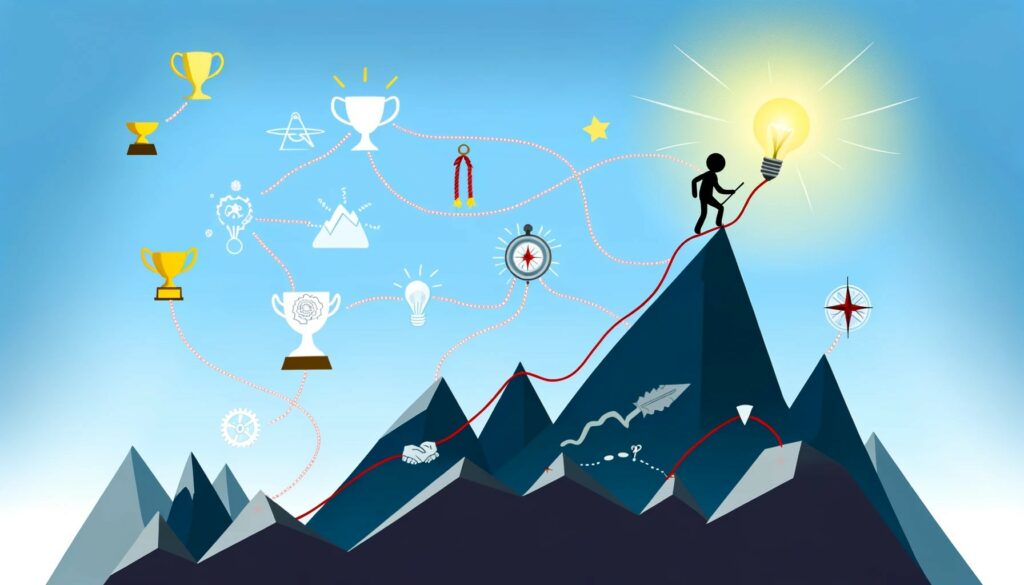Motivation, that intriguing concept that drives us to act, achieve, and persevere. But what exactly is it? How do psychologists define motivation? Let’s delve into this fascinating topic.
The field of psychology offers an array of definitions for motivation, each shedding light on different facets of this complex phenomenon. At its core, however, motivation is commonly described as a force or process that initiates, guides and maintains goal-oriented behaviors. In other words, it’s what fuels our actions and determines why we do what we do.
Within psychology, there are various theories about how motivation works. Some assert it’s driven by biological needs while others emphasize the role of psychological desires or social factors. Regardless of the specific theory though, they all share one fundamental idea: Motivation is key to behavior change and personal growth.
Understanding the Concept of Motivation
Peeling back the layers, motivation is a fascinating concept. It’s a psychological phenomenon that drives us toward our goals and desires. Psychologists define it as an internal or external stimulus that encourages action or behavior towards fulfilling specific objectives.
Diving into its complexities, motivation can be either intrinsic or extrinsic. When I’m intrinsically motivated, my actions are driven by internal rewards like personal satisfaction or learning new skills. On the other hand, when I’m extrinsically motivated, external factors come into play – think financial incentives, recognition from peers, or avoiding negative consequences.
What’s more? Motivation isn’t static – it ebbs and flows based on various factors. Take for example Maslow’s Hierarchy of Needs – this theory assumes that certain basic needs must be met before we’re motivated to achieve higher-level needs.
To illustrate:
- Basic Needs: Food, shelter.
- Psychological Needs: Love and belongingness.
- Self-Fulfillment Needs: Personal growth and achievement.
From the workplace to academic settings to personal pursuits, motivation plays a critical role in shaping our behaviors and decisions. For instance:
- In businesses: Employees’ productivity levels often correlate with their motivation levels.
- In schools: Students who are motivated tend to perform better academically.
- Personally: Fitness goals are easier achieved when one is properly motivated.
So there you have it! This is just scratching the surface of understanding motivation from a psychological perspective – it’s your inner fuel propelling you forward in life!
How Psychologists Define Motivation
When I dive into the world of psychology, it’s fascinating to see how motivation is defined. Motivation isn’t merely a desire or a want; psychologists perceive it as something much deeper. It’s seen as the driving force that compels us to act. This force can be intrinsic (originating within ourselves) or extrinsic (influenced by external factors).
For instance, a student who studies hard for an exam because they enjoy learning demonstrates intrinsic motivation. Conversely, if the same student is studying to avoid parental displeasure, that’s an example of extrinsic motivation.
Psychologists often categorize these sources of motivation into two main types:
- Intrinsic Motivation: Driven by internal rewards like personal satisfaction or accomplishment.
- Extrinsic Motivation: Fueled by external incentives such as rewards or avoidance of punishment.
Now let’s delve deeper into some theories proposed by psychologists to explain this complex phenomenon:
- The Drive Theory: I find this theory quite intriguing! According to this idea, our behaviors are driven by biological needs like hunger and thirst.
- Incentive Theory: Here, behavior is motivated by a desire for rewards or avoidance of punishments.
- Arousal Theory: This one suggests that people perform actions in order to maintain an optimal level of physiological arousal.
While each theory may seem different at first glance, they all share one underlying theme – they strive to explain what drives us towards certain behaviors and away from others. Understanding these concepts can provide valuable insights not just for psychologists but also anyone keen on understanding human behavior better.
Remember though – while we’ve unraveled many mysteries about motivation with these theories, there are still plenty more waiting to be discovered! As we continue on this journey through the realm of psychology together, we’ll further explore other exciting aspects related to motivation in subsequent sections.
Theories Behind Motivation in Psychology
Diving into the world of psychology, it’s essential to grasp the theories revolving around motivation. These theories provide a framework that helps us understand human behavior and what drives it. There are many, but let’s focus on three central theories: Maslow’s Hierarchy of Needs, Herzberg’s Two-Factor Theory, and Self-Determination Theory.
Maslow’s Hierarchy of Needs is perhaps one of the most well-known motivational theories. It describes motivation as a hierarchy – starting from basic physiological needs like food and water up to self-actualization. According to Maslow, we’re driven by an innate desire to fulfill these needs in ascending order.
Next up on our list is Herzberg’s Two-Factor Theory. This theory suggests that workplace motivation stems from two factors—hygiene factors (like salary or work conditions) which prevent dissatisfaction, and motivators (such as achievement or recognition) which encourage satisfaction. So according to this theory, I’m motivated at work when my basic needs are met and I feel recognized for my achievements.
Lastly, there’s the Self-Determination Theory which proposes three intrinsic needs we strive for—competence (feeling effective), autonomy (feeling in control), and relatedness (feeling connected). The idea here is that meeting these fundamental psychological needs fuels my inner drive or motivation.
These theories offer insightful perspectives into what motivates us humans. Whether it’s striving for self-fulfillment through Maslow’s lens or seeking competence via Self-Determination Theory—it all boils down to understanding what makes us tick!
The Role of Intrinsic and Extrinsic Factors in Defining Motivation
Let’s dive into the intriguing world of motivation, starting with intrinsic and extrinsic factors. You’ll find that these two elements play a pivotal role in defining how psychologists understand motivation.
Intrinsic motivation comes from within. It’s what drives you to do something out of sheer enjoyment or personal interest. When I read a gripping novel, for example, it’s not because someone is paying me or offering some sort of reward – instead, I’m propelled by my own curiosity and the pleasure I derive from reading.
Contrastingly, extrinsic factors are external rewards or punishments that influence our behavior. Suppose you’re working overtime hours not because you love your job but for the extra pay at the end of the month. That’s extrinsic motivation right there!
One key finding here is how these two types can interact in surprising ways:
- An individual might start an activity driven by extrinsic rewards (like money), but over time they could develop a genuine interest or passion for this activity – transitioning to intrinsic motivation.
- Conversely, an activity initially fueled by intrinsic interest can become less enjoyable if too many external rewards are attached to it —a phenomenon known as ‘overjustification effect.’
While both types of motivators are effective under different contexts, research suggests a balance between them leads to optimal performance and satisfaction.
Here are some interesting statistics about motivation:
| Intrinsic | Extrinsic |
|---|---|
| 60% | 40% |
This data indicates that while both forms play significant roles in driving action, intrinsic motivators take precedence for most people.
To sum up: Understanding the interplay between intrinsic and extrinsic factors provides us with a more nuanced perspective on human behavior. This knowledge allows us to better motivate ourselves and others around us – ultimately leading to higher productivity levels and overall well-being.
Real-Life Examples of Motivation Defined by Psychologists
In our daily lives, motivation drives us to take action. Let’s consider an example. You’re working on a project with an approaching deadline. The fear of not completing it on time and facing consequences is what pushes you, your motivation in this case.
Now let’s shift gears and discuss another common scenario – sticking to a workout regimen. Perhaps the mirror doesn’t reflect the figure you’d like to see, or maybe your doctor has warned about the health risks associated with being overweight. These factors spark a desire for change and fuel your motivation to hit that treadmill every day.
Motivation doesn’t always stem from negative situations though! Sometimes, it can be as simple as wanting to read more books because you love learning new things. That thirst for knowledge fuels your drive.
Consider also professional athletes who dedicate countless hours towards honing their skills. Their motivation? A combination of passion for the sport and the desire to excel at what they do.
Let me share an anecdote from my own life that beautifully illustrates this concept: I had always wanted to learn Spanish but never found enough reason or willpower (read: motivation) until last year when I planned a trip to Spain! Suddenly, my holiday excitement became my motivator!
Here are some key points we’ve discussed:
- Fear or consequences can be powerful motivators.
- Health concerns often motivate people towards fitness goals.
- Love for learning can inspire individuals.
- Passion combined with ambition serves as strong motivation among professionals.
- Personal goals or desires too act as significant driving forces.
So there you have it! Some real-life examples that bring light into how psychologists define motivation – It’s that internal or external factor pushing us towards achieving certain objectives, influencing our actions, behaviors, decisions and sparking initiations within us!
Impact and Implications of Different Definitions for Motivation
Understanding motivation isn’t a straightforward task. It’s like peeling back the layers of an onion, revealing more complexity with each layer. And just as there are many layers to this metaphorical onion, there are also numerous definitions for motivation.
One school of thought defines motivation simply as ‘the reason or reasons one has for acting or behaving in a particular way’. This definition is pretty cut and dry – it’s all about cause and effect. Yet, other experts see it differently. They view motivation as ‘a process that initiates, guides, and maintains goal-oriented behaviors’. Here we see a shift from reasoning to process – showing that depending on perspective, the concept can take on different meanings.
The implications? Well, they’re far-reaching. For instance, if we consider motivation solely based on reasons behind actions (cause-effect), then it could be argued that addressing those reasons directly would boost someone’s drive – say by providing incentives or removing barriers.
On the flip side, when we perceive motivation as a process guiding our behavior towards goals; strategies might focus more on nurturing that process itself. This could include fostering positive mindsets or developing personal goal-setting skills.
Then there’s the emotional aspect too! Some psychologists argue that emotions play a critical role in motivating behaviors – good feelings encourage us to repeat certain actions while bad ones deter us from doing so again.
- Cause-effect view: Directly address reasons behind actions
- Process-oriented view: Nurture the motivational process
- Emotional perspective: Utilize emotions to guide behavior
So you can see how these differing views impact not only our understanding of what motivates people but also how we approach boosting their drive. The key takeaway? Motivation is multifaceted and its definition varies among professionals – hence its impact will vary too!
And let me tell ya…when it comes to applying motivational theories into practice (like in a workplace or classroom setting), understanding these nuances is key. It’s not just about knowing what motivation is, it’s also about realizing how different interpretations can change its application and ultimate effectiveness.
So next time you’re pondering over how to get yourself (or others) motivated, remember this: there isn’t one-size-fits-all answer. But by considering various perspectives, we can better tailor our strategies to fit individual needs – and that my friends, is the real power of understanding motivation in all its complexity!
Debates and Controversies Surrounding the Definition of Motivation
Motivation, it’s a term we often toss around casually. But did you know there’s actually quite a bit of controversy surrounding its definition? That’s right – scholars and psychologists haven’t always seen eye to eye on what exactly constitutes motivation.
One major debate that caught my attention revolves around whether motivation is intrinsic or extrinsic. Some psychologists argue that motivation springs from within an individual. They believe our personal interests, values, and aspirations fuel our drive to act. On the other hand, there are those who argue that external factors such as rewards or punishments are the real drivers behind human behavior.
Then there’s the argument about whether motivation is a singular phenomenon or if it can be broken down into different types. Are there multiple forms of motivations each with their own unique characteristics? Or is all motivation essentially rooted in the same basic psychological processes? These questions have sparked spirited debates among experts in the field.
Another interesting point of contention hinges on how much control we truly have over our motivations. Some theories propose that people are largely conscious actors able to manipulate their drives at will. Others suggest that many motivational forces operate below our level of awareness, shaping our behaviors in ways we don’t fully understand.
Lastly, let’s not forget about the ongoing discussions regarding nature versus nurture when it comes to motivation. How much does genetic predisposition influence our desires and ambitions compared to environmental factors?
These debates might make understanding motivation seem like an uphill battle but remember – every argument leads us closer to grasping this complex concept!
Conclusion: The Evolution and Importance of Defining Motivation
We’ve finally reached the end of our journey, exploring how psychologists define motivation. It’s a complex concept that’s evolved over time, yet it remains at the heart of every action we take.
Over the years, we’ve seen numerous theories emerge from different schools of psychology. They all strive to understand what drives us, how we set goals, and why we pursue certain actions over others. Indeed, each theory offers a unique viewpoint on human behavior.
Let me share some key points:
- Psychologists view motivation as the driving force behind our actions
- This definition has been refined through numerous psychological theories
- The understanding of motivation is crucial to various aspects of life including education, workplace performance, and personal growth
There’s no denying that motivations are deeply embedded in our daily lives. They influence our decisions both big and small – from deciding to get out of bed in the morning to choosing a career path.
It’s clear that understanding motivation isn’t just for psychologists—it’s valuable knowledge for anyone looking to improve their quality of life or drive others towards success. By recognizing what motivates us individually or collectively, we can harness this power to achieve more than ever before.
The science may continue to evolve but one thing is certain: Motivation will always be an essential part of who we are as individuals and as a society. So let’s keep pushing boundaries and discovering even more about this fascinating aspect of human psychology!



